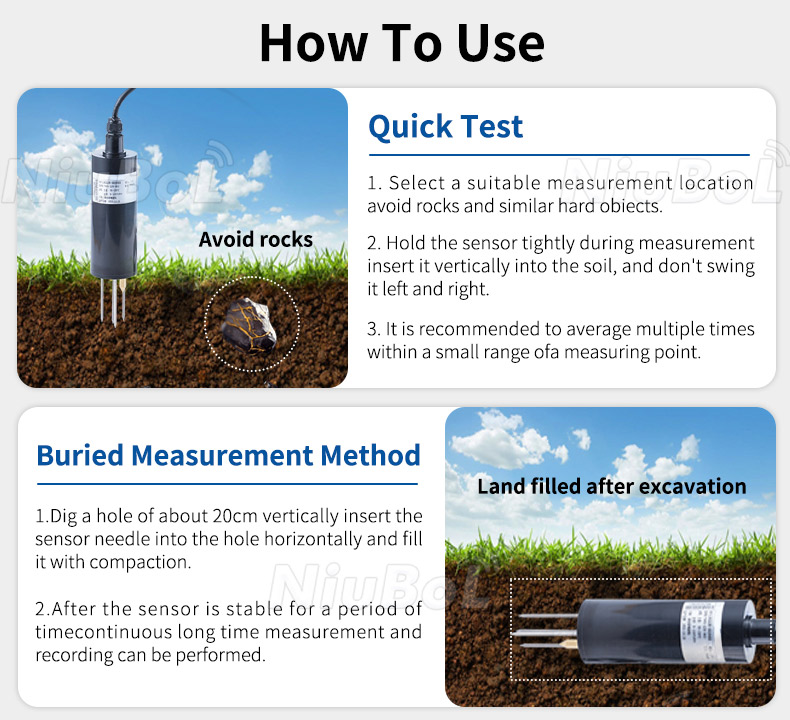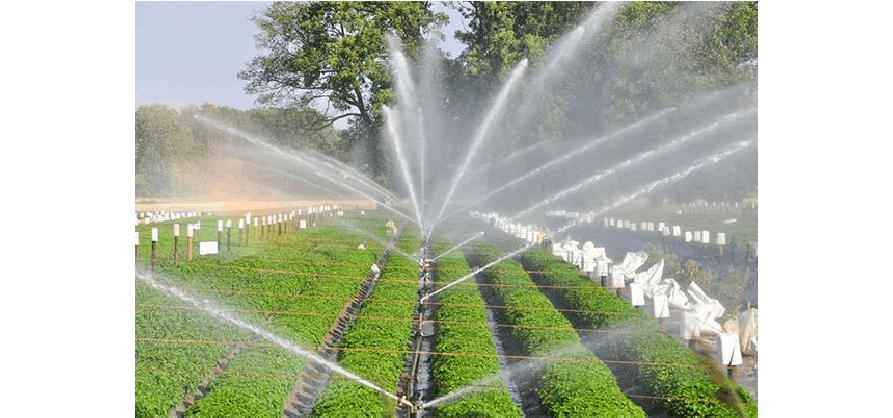

— Blogs —
—Products—
 Consumer hotline +8618073152920
Consumer hotline +8618073152920 WhatsApp:+8615367865107
Address:Room 102, District D, Houhu Industrial Park, Yuelu District, Changsha City, Hunan Province, China
Product knowledge
Time:2025-10-24 18:01:54 Popularity:735
In the wave of agricultural digitalization, soil moisture sensors are evolving from auxiliary instruments into central components of farm decision-making. Facing frequent droughts, water stress, and climate uncertainty, farmers increasingly rely on real-time soil moisture data to achieve precision irrigation and operational efficiency.
According to Grand View Research (2024), the global soil moisture sensor market reached USD 370 million in 2023 and is projected to exceed USD 900 million by 2030, with a compound annual growth rate (CAGR) of approximately 14%.
Between 2025 and 2030, the market will enter an acceleration phase driven by three key factors:
IoT integration across farms, AI analytics platforms enabling predictive irrigation, and Supportive government policies for sustainable agriculture.

Initially used mainly for scientific research — such as the USDA Soil Moisture Monitoring Program — soil sensors are now widely deployed across commercial farms. The mainstream technologies include:
Capacitive sensors: corrosion-resistant, low power consumption, ideal for long-term buried use.
TDR/FDR reflection sensors: high precision, best for research and automated irrigation.
Multi-parameter sensors: measure moisture, temperature, EC, and pH simultaneously.
The FAO reports that agriculture consumes over 70% of global freshwater. Extreme weather in Europe and Australia during 2024 further underscored the need for precise water management. Studies show that soil moisture-based irrigation can save 20–40% of water while stabilizing crop yields.
The EU Green Agriculture Program (CAP) offers up to 50% subsidy for sensor installations.
The U.S. Climate Smart Agriculture Initiative promotes smart irrigation networks.
China’s “14th Five-Year Digital Agriculture Strategy” drives IoT deployment in major grain zones.
Thanks to LoRa and NB-IoT adoption, deployment costs per acre have dropped from over CNY 1,000 to under 300, accelerating adoption across developing markets.
Research and Markets (2025) forecasts the global soil moisture sensor market to rise from USD 450 million in 2025 to over USD 1 billion by 2030, at an average annual growth rate of 13–14%.
Between 2025 and 2030, the soil sensor industry will advance through three major transformations — integration, intelligence, and ecosystem connectivity.
Traditional single-function probes are being replaced by multi-sensor modules.
Niubol’s next-generation NBL-S-TMC-7 sensor integrates temperature, moisture, EC, and pH monitoring into one device — reducing maintenance costs and data complexity.
Modern IoT sensors combined with AI-driven platforms can identify irrigation patterns and optimize schedules based on crop type, soil composition, and weather forecasts.
Sensor networks now integrate with weather stations, fertilizer injectors, and UAV imaging systems, forming a complete Agricultural IoT ecosystem.
Through platforms such as Niubol Cloud, farmers can visualize historical moisture data, overlay it with local weather forecasts, and receive automated irrigation recommendations.
The U.S. remains the largest market, accounting for over 30% of global demand. Farms in California, Texas, and the Midwest commonly use LoRa-based networks linked to central irrigation systems.
Germany and the Netherlands lead in greenhouse automation, using dense sensor networks to regulate ventilation and water use. The EU aims for 70% digital farm coverage by 2030.
China and India are the fastest-growing markets.
China’s “Smart Agriculture Demonstration Zones” drive sensor adoption with over 15% annual growth.
India’s NICRA program promotes low-cost IoT soil monitoring systems for drought-prone regions.
Brazil and Chile focus on water-efficient farming, while Saudi Arabia and the UAE rapidly deploy desert greenhouse projects with soil moisture monitoring to combat extreme aridity.

Capacitive sensors are ideal for long-term monitoring; TDR sensors offer the highest precision but at higher cost; resistive sensors are better suited for teaching or short-term use.
Use factory-calibrated probes, avoid rocky or pipeline areas, and ensure good soil contact. Niubol sensors feature automatic temperature compensation for enhanced accuracy.
Niubol LoRa series supports offline data logging and scheduled uploads, perfect for remote or rural locations.
Typically, one node per 5–10 hectares provides reliable regional data, depending on soil uniformity.
Through Modbus or MQTT protocols, sensors can trigger irrigation events based on real-time soil data.

Niubol delivers high-precision IoT-based agricultural monitoring solutions, including:
Soil Multi-Parameter Sensors (NBL-S-TM Series)
Wireless Data Loggers (LoRa/4G)
Automatic Weather Stations and Niubol Cloud Analytics Platform
Niubol systems are deployed in China, Brazil, India, Spain, and Mongolia, helping farmers implement smart irrigation, fertigation management, and sustainable crop production.
Visit www.niubol.com to learn how Niubol IoT sensors can optimize your irrigation system. Precision agriculture—from “farming by weather” to “farming by data.”
The years 2025–2030 will mark the golden era for the soil moisture sensor market.
With the convergence of AI, 5G, and satellite technologies, soil sensors will evolve from measurement tools to the foundation of intelligent agricultural ecosystems.
Whether in large-scale farms or precision greenhouses, data-driven irrigation will define the next generation of sustainable agriculture.
Niubol believes the future of smart farming is not only about increasing yields but also about ensuring that every inch of soil and every drop of water is used wisely.
1.NBL-S-THR Soil Temperature Moisture Sensor datasheet
NBL-S-THR-Soil-temperature-and-moisture-sensors-Instruction-Manual-V4.0.pdf
2. NBL-S-TMC Soil Temperature Moisture EC Sensor datasheet
NBL-S-TMC-Soil-temperature-and-moisture-conductivity-sensor.pdf
3. NBL-S-TM Soil Temperature Moisture Sensor datasheet
NBL-S-TM-Soil-temperature-and-moisture-sensor-Instruction-Manual-4.0.pdf
4. NBL-S-TMCS Soil Temperature, Moisture, Conductivity and Salinity Integrated Sensor
NBL-S-TMCS-Soil-Temperature-Humidity-Conductivity-and-Salinity-Sensor.pdf
Related recommendations
Sensors & Weather Stations Catalog
Agriculture Sensors and Weather Stations Catalog-NiuBoL.pdf
Weather Stations Catalog-NiuBoL.pdf
Related products
 Combined air temperature and relative humidity sensor
Combined air temperature and relative humidity sensor Soil Moisture Temperature sensor for irrigation
Soil Moisture Temperature sensor for irrigation Soil pH sensor RS485 soil Testing instrument soil ph meter for agriculture
Soil pH sensor RS485 soil Testing instrument soil ph meter for agriculture Wind Speed sensor Output Modbus/RS485/Analog/0-5V/4-20mA
Wind Speed sensor Output Modbus/RS485/Analog/0-5V/4-20mA Tipping bucket rain gauge for weather monitoring auto rainfall sensor RS485/Outdoor/stainless steel
Tipping bucket rain gauge for weather monitoring auto rainfall sensor RS485/Outdoor/stainless steel Pyranometer Solar Radiation Sensor 4-20mA/RS485
Pyranometer Solar Radiation Sensor 4-20mA/RS485
Screenshot, WhatsApp to identify the QR code
WhatsApp number:+8615367865107
(Click on WhatsApp to copy and add friends)
